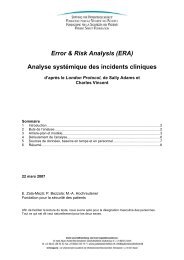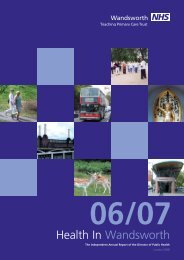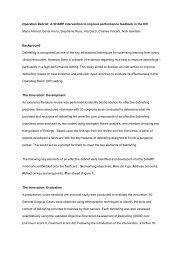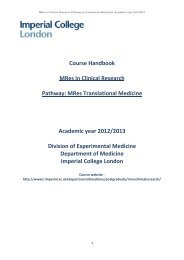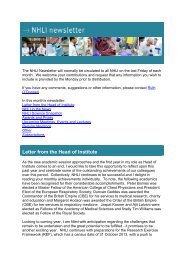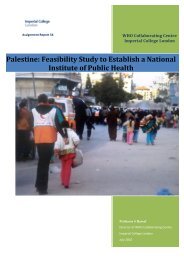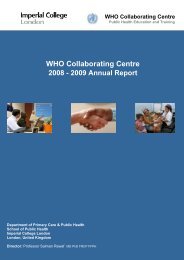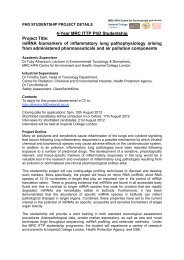Risk factors for healthcare-associated urinary tract infection and their ...
Risk factors for healthcare-associated urinary tract infection and their ...
Risk factors for healthcare-associated urinary tract infection and their ...
- No tags were found...
You also want an ePaper? Increase the reach of your titles
YUMPU automatically turns print PDFs into web optimized ePapers that Google loves.
226C. King et al. / Journal of Hospital Infection 82 (2012) 219e22615. Solutions <strong>for</strong> Public Health. Critical appraisal skills programme ecohort studies. UK: NHS; 2004.16. S<strong>and</strong>erson S, Tatt ID, Higgins JP. Tools <strong>for</strong> assessing quality <strong>and</strong>susceptibility to bias in observational studies in epidemiology:a systematic review <strong>and</strong> annotated bibliography. Int J Epidemiol2007;36:666e676.17. Last J. A dictionary of epidemiology. 4th ed. Ox<strong>for</strong>d: Ox<strong>for</strong>dUniversity Press; 2001.18. Pietrantojn CD. Four-fold table cell frequencies imputation inmeta analysis. Stat Med 2006;25:2299e2322.19. World Health Organization. ICD-10 classifications of mental <strong>and</strong>behavioural disorder: clinical descriptions <strong>and</strong> diagnostic guidelines.Geneva: WHO; 1992.20. Al-Helali NS, Al-Asmary SM, Abdel-Fattah MM, Al-Jabban TM, Al-Bamri AL. Epidemiologic study of nosocomial <strong>urinary</strong> <strong>tract</strong> <strong>infection</strong>sin Saudi military hospitals. Infect Control Hosp Epidemiol2004;25:1004e1007.21. Hedstrom M, Grondal L, Ahl T. Urinary <strong>tract</strong> <strong>infection</strong> in patientswith hip fractures. Injury 1999;30:341e343.22. Nguyen-Van-Tam SE, Nguyen-Van-Tam JS, Myint S, Pearson JC. <strong>Risk</strong><strong>factors</strong> <strong>for</strong> hospital-acquired <strong>urinary</strong> <strong>tract</strong> <strong>infection</strong> in a large Englishteaching hospital: a caseecontrol study. Infection 1999;27:192e197.23. Brindha SM, Jayashree M, Singhi S, Taneja N. Study of nosocomial<strong>urinary</strong> <strong>tract</strong> <strong>infection</strong>s in a pediatric intensive care unit. J TropPediatr 2011;57:357e362.24. Dantas SR, Kuboyama RH, Mazzali M, Moretti ML. Nosocomial<strong>infection</strong>s in renal transplant patients: risk <strong>factors</strong> <strong>and</strong> treatmentimplications <strong>associated</strong> with <strong>urinary</strong> <strong>tract</strong> <strong>and</strong> surgical site <strong>infection</strong>s.J Hosp Infect 2006;63:117e123.25. De Ruz AE, Leoni EG, Cabrera RH. Epidemiology <strong>and</strong> risk <strong>factors</strong><strong>for</strong> <strong>urinary</strong> <strong>tract</strong> <strong>infection</strong> in patients with spinal cord injury.J Urol 2000;164:1285e1289.26. Graves N, Tong E, Morton AP, et al. Factors <strong>associated</strong> with <strong>healthcare</strong>-acquired <strong>urinary</strong> <strong>tract</strong> <strong>infection</strong>. Am J Infect Control2007;35:387e392.27. Herruzo-Cabrera R, Lopez-Gimenez R, Cordero J, Munuera L.Urinary <strong>infection</strong> after orthopedic procedures. Int Orthopaed2001;25:55e59.28. Larsen RA, Burke JP. The epidemiology <strong>and</strong> risk <strong>factors</strong> <strong>for</strong> nosocomialcatheter-<strong>associated</strong> bacteriuria caused by coagulasenegativestaphylococci. Infect Control 1986;7:212e215.29. Laupl<strong>and</strong> KB, Zygun DA, Davies HD, Church DL, Louie TJ, Doig CJ.Incidence <strong>and</strong> risk <strong>factors</strong> <strong>for</strong> acquiring nosocomial <strong>urinary</strong> <strong>tract</strong><strong>infection</strong> in the critically ill. J Crit Care 2002;17:50e57.30. Laupl<strong>and</strong> KB, Bagshaw SM, Gregson DB, Kirkpatrick AW, Ross T,Church DL. Intensive care unit-acquired <strong>urinary</strong> <strong>tract</strong> <strong>infection</strong>s ina regional critical care system. Crit Care 2005;9:R60eR65.31. Leone M, Albanese J, Garnier F, et al. <strong>Risk</strong> <strong>factors</strong> <strong>for</strong> nosocomialcatheter-<strong>associated</strong> <strong>urinary</strong> <strong>tract</strong> <strong>infection</strong> in a polyvalent intensivecare unit. Intens Care Med 2003;29:1077e1080.32. Ovbiagele B, Hills NK, Saver JL, Johnston SC. Frequency <strong>and</strong>determinants of pneumonia <strong>and</strong> <strong>urinary</strong> <strong>tract</strong> <strong>infection</strong> duringstroke hospitalization. J Stroke Cerebrovasc Dis 2006;15:209e213.33. Tissot E, Limat S, Cornette C, Capellier G. <strong>Risk</strong> <strong>factors</strong> <strong>for</strong>catheter-<strong>associated</strong> bacteriuria in a medical intensive care unit.Eur J Clin Microbiol 2001;20:260e262.34. Traxel E, DeFoor W, Reddy P, Sheldon C, Minevich E. <strong>Risk</strong><strong>factors</strong> <strong>for</strong> <strong>urinary</strong> <strong>tract</strong> <strong>infection</strong> after dextranomer/hyaluronic acid endoscopic injection. J Urol 2009;182(Suppl.):1708e1712.35. Vazquez-Aragon P, Lizan-Garcia M, Cascales-Sanchez P, Villar-Canovas MT, Garcia-Olmo D. Nosocomial <strong>infection</strong> <strong>and</strong> related risk<strong>factors</strong> in a general surgery service: a prospective study. J Infect2003;46:17e22.36. Kampf G, Gastmeier P, Wischnewski N, et al. Analysis of risk<strong>factors</strong> <strong>for</strong> nosocomial <strong>infection</strong>s e results from the first nationalprevalence survey in Germany (NIDEP study 1). J Hosp Infect1997;37:103e112.37. Mnatzaganian G, Galai N, Sprung CL, et al. Increased risk ofbloodstream <strong>and</strong> <strong>urinary</strong> <strong>infection</strong>s in intensive care unit (ICU)patients compared with patients fitting ICU admission criteriatreated in regular wards. J Hosp Infect 2005;59:331e342.38. Rosser CJ, Bare RL, Meredith JW. Urinary <strong>tract</strong> <strong>infection</strong>s in thecritically ill patient with a <strong>urinary</strong> catheter. Am J Surg 1999;177:287e290.39. Talaat M, Hafez S, Saied T, Elfeky R, El-Shoubary W, Pimentel G.Surveillance of catheter-<strong>associated</strong> <strong>urinary</strong> <strong>tract</strong> <strong>infection</strong> in 4intensive care units at Alex<strong>and</strong>ria university hospitals in Egypt. AmJ Infect Control 2010;38:222e228.40. Vanhems P, Baratin D, Voirin N, et al. Reduction of <strong>urinary</strong> <strong>tract</strong><strong>infection</strong>s acquired in an intensive care unit during a 10-yearsurveillance program. Eur J Epidemiol 2008;23:641e645.41. Platt R, Polk BF, Murdock B, Rosner B. <strong>Risk</strong>-<strong>factors</strong> <strong>for</strong> nosocomial<strong>urinary</strong>-<strong>tract</strong> <strong>infection</strong>. Am J Epidemiol 1986;124:977e985.42. Dindo D, Muller MK, Weber M, Clavien P- A. Obesity in generalelective surgery. Lancet 2003;361:2032e2035.43. Jankovic S, Radosavljevic V. <strong>Risk</strong> <strong>factors</strong> <strong>for</strong> bladder cancer.Tumori 2007;93:4e12.44. Connor J, Norton R, Ameratunga S, et al. Driver sleepiness <strong>and</strong> riskof serious injury to car occupants: population based case controlstudy. BMJ 2002;324:1125.45. Madigan MP, Ziegler RG, Benichou J, Byrne C, Hoover RN.Proportion of breast cancer cases in the United States explainedby well-established risk <strong>factors</strong>. J Natl Cancer Inst 1995;87:1681e1685.46. National Health Service Classification Service. Coding clinic. 2011.47. Schweizer ML, Eber MR, Laxminarayan R, et al. Validity ofICD-9-CM coding <strong>for</strong> identifying incident methicillin-resistantStaphylococcus aureus (MRSA) <strong>infection</strong>s: is MRSA <strong>infection</strong>coded as a chronic disease? Infect Control Hosp Epidemiol2011;32:148e154.48. Evans RS, Burke JP, Classen DC, et al. Computerized identificationof patients at high-risk <strong>for</strong> hospital-acquired <strong>infection</strong>. Am J InfectControl 1992;20:4e10.49. Woeltje K, McMullen K, Butler AM, Goris AJ, Doherty J. Electronicsurveillance <strong>for</strong> <strong>healthcare</strong>-<strong>associated</strong> central line-<strong>associated</strong>bloodstream <strong>infection</strong>s outside the intensive care unit. Infect ContHosp Epidemiol 2011;32:1086e1090.50. Lazarus R, Kleinman K, Dashevsky I, deMaria A, Platt R. Usingautomated medical records <strong>for</strong> rapid identification of illnesssyndromes (syndromic surveillance): the example of lower respiratory<strong>infection</strong>. BMC Public Health 2001;1:9.



